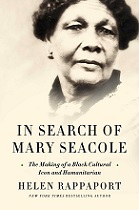
One of the reasons I love to read is because there is always something new to learn. In fact, I would go as far to say there is always a new story waiting to be learned of. I saw this book while browsing for a new read and could not recall seeing the name of Mary Jane Seacole (1805-1881) previously. The image did look familiar but the story behind the face eluded me. There was only one thing left to do so I bought the book. And what I found is a story that is unique, interesting, and beneficial in discovering history that should be more widely known. Author Helen Rappaport went on a search for the real Mary Seacole, and though there are parts of her life lost to history, this account of her life is a solid foundation.
I have seen online that debates continue in whether Seacole should be recognized as a nurse, businesswoman or other. The truth is that she was a mix of both and took advantage of the opportunities that came into her life. Her story begins on the island of Jamaica in the early 1800s. The author provides a good discussion of life in that Caribbean nation, then under the control of the British Government. England’s influence can be felt throughout the story, particularly during the Crimea War which Mary sees firsthand. But first, the story of Mary’s life plays out in Kingston, Jamaica. And this includes her marriage to Edwin Seacole (1803-1844). Following his death, Mary’s life took off and we follow her journey to Central America and Great Britain. She rarely sits still in the book and when the war breaks out, she moves again, determined to make her way to the battlefront to assist in any way possible. And it is here that I believe the confusion and controversy over her exact title begins.
To be clear, Seacole was never designated as “nurse” in the traditional sense. However, she did render aid to wounded soldiers and had prior experience in confronting cholera, still largely misunderstood and without clear remedy. Today, we have an arsenal of tools to fight a cholera outbreak but in Seacole’s time, treatment was non-existent and home remedies were experimental. Further, Seacole was a businesswoman who had success and extensive contacts in the British military. But that success also came with enemies. And readers may be surprised to learn of the animosity between Seacole and the well-known Florence Nightingale (1820-1910). This part of the book did catch me off guard and the dislike and envy from Nightingale is glaringly apparent. Seacole was not a nurse, but she could not be ignored. Rappaport establishes Seacole’s importance with the remark that:
“There is no doubt that from the late 1850s to her death in 1881, Mary Seacole was the most famous Black woman in the British Empire. Indeed, until she was voted Greatest Black Briton in 2004, only the Trinidadian pianist Winifred Atwell and the Welsh mixed-heritage singer Shirley Bassey had enjoyed an equivalent celebrity; but their popularity had not come until after the Second World War.”
Seacole’s life was amazing but the biggest mystery in the book is her alleged daughter Sarah, also known as “Sally”. This part of the book leaves room for further research but from all indications, Sally disappeared, and her life remains unknown. However, that did not stop Nightingale from entering the fray and her allegations about Sarah’s parents are startling, but no conclusive evidence was ever produced. We may never know what happened to Sarah, but she did exist and is part of this story.
Following the war, Mary moves around again, and finds herself in declining health. And on May 14, 1881, died in London at the age of seventy-five. Decades after her death the Jamaican government officially recognized her life and today, she is seen as an iconic figure in both Jamaican and British history but during her time, she endured hardships, heartache, racial prejudice, and sexism but persevered, nonetheless. This is a fascinating read about a figure who made her mark in history at a time when blacks and mixed-race people were still held in bondage. History buffs will also like that the author asks for any contributions to Seacole’s life be made online so if you do know more about her life that is not in the book, you can send the author your suggestions to make the Seacole story as complete as possible.
ASIN: B09SGP3WJB
